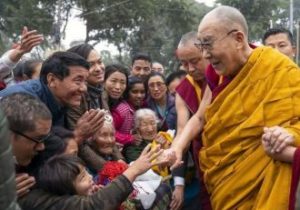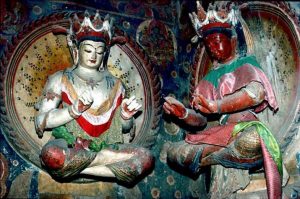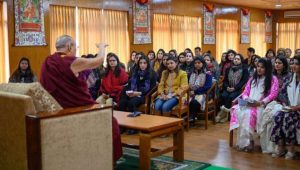Imagine you’re about to sail the azure sea and reap its more positive maritime possibilities: trade, prosperity, or perhaps cultural exchange. But have you thought about the perilous journeys your cross necklace or wrist beads undergo to journey with their owners? Religious artifacts embody something at once primal and transcendent about human nature. People have been known to protect religious articles to the point of happily overriding their own basic sense of self-preservation. What a story, then, must it be for a devout person to embark on the seas with their pious statues, small shrines, sculptures, and even talismans or jewelry.
Here is something truly worth setting sail for: the ECAI Atlas of Maritime Buddhism Project. It’s an initiative to building new understandings of the Buddhist past. For more than a century we have seen the growth of interest in Silk Road research, and the identification of these mercantile routes as the major element in the transmission of Buddhism to China. But there is considerable available knowledge about Buddhist pilgrims, Buddhist kingdoms, and trade routes in South and Southeast Asia, and a growing awareness of the maritime contribution to the global network of trade and cultural diffusion.
As a historical project, the Atlas involves ambitious things: building a global team of researchers*, utilizing new data collection technologies, and using advanced data mapping and visualization to integrate cutting-edge results about the movements and trails of bygone ships and sailors.
Historically, mercantile activity was closely tied to the spread of Buddhism. We know that Buddhism was in many ways a religion of merchants as it made its way up and over the Pamir Mountains and into the Tarim basin. But the savvy dealers of Eurasia were not limited to caravans. There was an important group that operated a circuit of sea trade. And hence the million-dollar question: What was the role of these sea traders in the cultural life of Buddhism and, indeed, Eurasia? How does maritime Buddhism fit into the bigger picture of world history?
Buddhist history, like all other “histories,” can’t be understood in a vacuum. Non-Buddhist events like Alexander’s invasion of India and the rise of Islam all impacted trade and culture, and therefore had an effect on Buddhism too. We don’t have a complete picture of the diffusion process, but we do have some ideas about the impact of Buddhism on certain maritime trade and kingdoms.
Take Tamil Nadu, for instance. It had an intensive maritime trade link with western countries, Chinese and Southeast Asian regions. The numerous Roman coins and pottery attest to its role as a trading hub between South Asian, African and Mediterranean regions. There are also a good number of Chinese coins and products from China and Southeast Asia. The famous Chinese pilgrim, Xuanzang (he visited India in 629 – 645), wrote of a place called Molo-ku-ta or Malakuta at Tamil Nadu. During his visit, he recorded that he saw many remains of old monasteries. Xuanzang also mentioned Kancipuram, which apparently had dozens of vih?ras that were all populated by monks of the Sthavirav?da tradition. He might have been exaggerating when he talked of “ten thousand” monks (a suspiciously round number), but it doesn’t change the intriguing reality that the majority of locales with Buddhist remains are also reported to have flourished as trade centers, yielding Chinese and South-East Asian pottery datable from the 9th to 14th centuries – almost the entirety of the medieval period.
Or what about Kavirippumpattinam, the celebrated capital and port city of the illustrious Cholas of the Cankam civilization (2nd century BC to 2nd century AD)? Ptolemy of the first century referred to this place as Kaberis Emporion, and Periplus of the Erthrian Sea called it as Camara. Tamil literature of the first three centuries AD gives a vivid account of Cholas, its harbor, sailors, merchants, and wares. Once more, a large number of Roman, Chinese and Southeast Asian materials have found here.
Exploring the Great Circle
The Atlas can show us how Buddhists of ancient times traveled the great circle. The preservation of archaeological sites is obviously imperative, since they contain Buddhist remains. Shipwrecks give us information about how materials were transported and traded. But we still don’t know what the pattern of migration, trade and diffusion was. How was it that Buddhism came to China influenced by its journey through South and Southeast Asia? What was the impact of Southeast Asian ideas on Buddhist culture, like the writing of Buddhist texts?
There is much to do. Primary approaches to research would include making digitally dynamic maps with the traditional historical, contextual maps, collating a GIS collection of sites, harbor locations, and shipwrecks, cataloguing locations and characteristics of Buddhist materials in historical sites and on ships, and digitizing artifacts, images, and inscriptions. As if this were not enough, there’s more. A truly modern and high-tech approach to research involves 3D, user-interactive data capturing and inscriptional and artistic details that reveal the nature of Buddhist activities. Kevin Cain of Insight Digital will be one of the collaborators in helping to preserve this cultural heritage.
The Silk Road remains one of the most important processes by which Buddhism spread across Eurasia. But if we look at the intriguing Buddhist artifacts excavated, from western India to Java, we find an equally exciting and inspiring history. Professor Lewis Lancaster is one of the scholars who have been making inroads in this field of studies. Perhaps it really is time for the Silk Road was “upgraded,” so to speak, into the Great Circle of Buddhism. It mightn’t sound so romantic, but it certainly is more accurate – and cutting-edge.
http://player.vimeo.com/video/43581226
Prof Lewis Lancaster on the Maritime Buddhism project from buddhistdoor on Vimeo.
* Project Partners:
INSIGHT http://www.insightdigital.org
Institute for Study and Integration of Graphical Heritage Techniques
University of California (Berkeley) http://berkeley.edu/
Academia Sinica (Taiwan) http://www.sinica.edu.tw/main_e.shtml
University of Paris, Central Research Center
French National Centre for Scientific Research, (C.N.R.S) http://www.cnrs.fr/index.php
École française d’Extrême-Orient (EFEO) http://www.efeo.fr/index.php?l=EN
Archaeological Survey of India http://asi.nic.in/
National University of Singapore http://www.nus.edu.sg/
Institute of South East Asian Studies, Singapore http://www.iseas.edu.sg/
The Nalanda-Sriwijaya Centre at the Institute of Southeast Asian Studies (Iseas) http://nsc.iseas.edu.sg/upcoming_events.htm
University of the West, Rosemead, California http://www.uwest.edu/site/
Atlas of Martime Buddhism
Contact Information
Professor Lewis Lancaster
Director of the Electronic Cultural Atlas Initiative (ECAI)
School of Information
University of California, Berkeley
E-mail: [email protected]
Jeanette Zerneke
ECAI Technical Director
E-mail: [email protected]
















